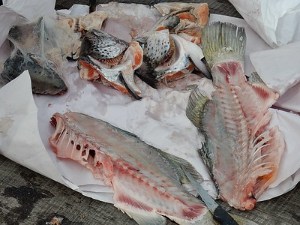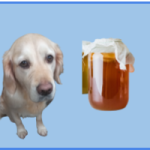
I know how you feel.
You have just filleted some fish for dinner and there on the cutting board are the fish bones.
Part of you is thinking “it would be a shame to waste them” and part of you is thinking “if I put these in the trash and it stinks the kitchen out, the wife will throttle me”..
Caught between a rock and a hard plaice (did you like my fish puns?) you think about giving them to your dog.
But how sensible is this?
Let’s find out.
Can dogs eat raw fish bones?
You should never feed raw fish bones to your dog because they are a massive choking hazard.
My (ex) wife once choked on a fish bone for so long without being able to dislodge it that we had to go to the emergency room so that they could remove it.
Fish bones are like that, aren’t they?
Very “dogged” (another pun) and determined to hang around if they are given half a chance…
Or, even if your dog will eat the bones as delicately as if they were using a knife and fork, and the fish skeleton doesn’t choke your dog, then those tiny sharp individual bones might cut or graze the lining of their gastrointestinal tract.
So even if the strong pong that is emanating from the bones is making your dog’s mouth water, don’t be tempted to feed it to them.
Can dogs eat cooked fish bones?
When you consider other animals bones for dogs, one of the rules seems to be that raw bones are much better for them than cooked bones.
When bones are cooked, they become more brittle and more likely to break into pieces with sharp ends.
These ends can hurt a dog by poking, cutting or grazing their insides after they have been swallowed.
So where does that leave cooked fish bones?
I don’t think that cooking fish bones makes them any more dangerous than they already are.
And so the answer is still don’t feed cooked fish bones to your dog.
But, there is a way that you can use cooked fish bones safely with your dog and I shall spill the beans after I have discussed fish heads.
Can dogs eat a raw fish head?
The focus of this article doesn’t get any less disgusting does it?
A raw (or cooked) fish head must seem as attractive to a dog as gobstoppers are to children.
And the potential for mishap is just as high.
For many dogs, a fish head is the kind of size where they might look at it and think “no need to chew that, I can just swallow it.”
And down it goes disappearing more quickly than a flash of lightning.
Only to get stuck at the back of their throat.
For some teeny tiny dogs, a fish head might be a safe treat for them to gnaw on.
And I am thinking about your Chihuahuas, Shih Tzus, Yorkshire Terriers..
Fish broth- the best way for your dog to eat fish bones
A while ago I teased you with the idea of using fish bones in a safe and constructive way for your dog.
And that method is to use them to make a fish broth or stock.
And once the broth has finished cooking it can be used like a gravy with your dog adding a bit of flavour and dampness to their main meal.
It will have most of the advantages of fish bones- lots of flavour and heaps of nutrients such as collagen.
Without any of the hazards.
The hardest part about making any bone broth is waiting whilst it cooks- and then storing it once it is cooled!
Oh yeah- and putting up with the very strong smell that will pollute your house.
But the process itself is simple as there are very few ingredients.
A great recipe to follow can be found on this page, under the heading “fish stock.”
Should dogs eat raw fish?
The great thing about raw fish is that it is so easy to prepare and then put into your dog’s bowl.
But should your dog be eating it?
The answer is probably not because of the bacteria that can be found in all sorts of raw fish.
And the only way to kill them is to cook the fish.
Now raw fish isn’t alone in being a parasite and bacteria magnet.
All types of meat are known to carry one sort of bacteria or another.
And when I say this, I don’t mean that every piece of chicken or every piece of pork is infected because that isn’t the case.
It is just that a piece of meat from any animal might contain bacteria.
For raw fish, the list of possible parasites includes several types of worm- tapeworms and roundworms are possible.
Bacteria- wise, it’s our old friend salmonella (who makes an appearance in this article about chicken), clostridium and listeria.
I have struggled to come up with any stats to show how common it is for people to get ill from eating raw fish, or what percentage of fish are infected with bacteria.
Unfortunately, the only numbers I can find relate to poisoning from oysters in 2014.
Having looked at the dangers of eating raw fish, I will now move on and consider which fish has the easiest set of bones.
Which fish has the easiest bones to remove?
And guess what? The fish with the easiest set of bones to remove doesn’t exist.
Instead the task relies on the skill of the person holding the knife (I’m in trouble with this one) instead of it being all about the fish.
“Shame!” I hear you cry..
So instead I will show you a quick YouTube video demonstrating how to fillet a fish.
It stars the one and only Gordon Ramsey no less!
How long does it take a dog to digest raw fish bones?
It is too late now.
For the right and wrong reasons you fed your dog the fish bones and you know what, there are no major dramas.
As long as all the bones have had a smooth passage to your dog’s stomach, then within a few hours they would have begun to be digested.
Yes, it is quite incredible but at times a dog’s stomach has the acidity of battery acid, which is more than enough to digest some fish bones.
In the stomach they are turned into something called chyme, which is a bit like liquid bone before moving on into the intestine.
And hopefully that means that your dog is fine, but what happens if part or all of the fish skeleton gets stuck somewhere deep inside your dog’s digestive system?
What are the symptoms of an intestinal blockage?
It would be fairly obvious if the fish bones got caught at the back of your dog’s throat because your dog would be coughing and retching until the offending article popped back out.
But what if they get caught further down?
At this point, you haven’t got the sound of your dog retching as a clue but there are other symptoms.
If your dog vomits up partially digested food that should ring alarm bells because that food could only get so far before it got stuck and then reappeared.
The next three symptoms of a blockage relate to a dog’s poop.
What you will notice with all of these symptoms is that your dog finds going to toilet much, much harder than usual.
And the three symptoms are; bloody stools, consistent diarrhea or constipation.
Should dogs eat raw or cooked bones?
I have already mentioned this in passing but raw bones are far safer than cooked bones as far as your dog is concerned.
Raw bones are far tougher and less likely to shatter than cooked bones.
But using bones safely with dogs is a bit more involved than merely choosing raw bones over cooked bones.
In the next section, I will look at another important rule to try and follow.
Should dogs eat big or small bones?
Just as there is a marked difference between the toughness of a raw bone versus a cooked bone, so is there difference in the density of weight bearing bones from an animal and non weight bearing bones from the same animal.
Thinking about very small breeds of dogs we could take a chicken as an example.
A leg bone is a better bone to give them than a set of wing bones.
And for a larger breed dog, we might consider a pig.
Once again, a leg bone will be safer than a rib bone because it is weight bearing- obviously.





